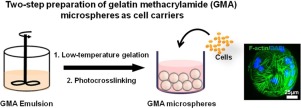当前位置:
X-MOL 学术
›
Colloids Surf. B Biointerfaces
›
论文详情
Our official English website, www.x-mol.net, welcomes your
feedback! (Note: you will need to create a separate account there.)
An efficient two-step preparation of photocrosslinked gelatin microspheres as cell carriers to support MC3T3-E1 cells osteogenic performance.
Colloids and Surfaces B: Biointerfaces ( IF 5.4 ) Pub Date : 2020-01-15 , DOI: 10.1016/j.colsurfb.2020.110798 Ji Jiang 1 , Amin Liu 1 , Chunlan Chen 2 , Jiajia Tang 1 , Hongjun Fan 2 , Jing Sun 1 , Hongsong Fan 1
Colloids and Surfaces B: Biointerfaces ( IF 5.4 ) Pub Date : 2020-01-15 , DOI: 10.1016/j.colsurfb.2020.110798 Ji Jiang 1 , Amin Liu 1 , Chunlan Chen 2 , Jiajia Tang 1 , Hongjun Fan 2 , Jing Sun 1 , Hongsong Fan 1
Affiliation

|
Gelatin microspheres have been commonly used in tissue engineering, but their application is often limited by the uncontrollability and potential cytotoxicity of traditional chemical cross-linking method. Methylacrylamide modification and photocrosslinking provide a controllable and cytocompatible cross-linking method for gelatin hydrogels, however, microspheres fabricated by this single photopolymerization process is uncontrollable. In this study, we show that increasing the gelling ability of gelatin methacrylamide (GMA) at low temperatures is vital to prepare photocrosslinked gelatin microspheres, which in turn improves the controllability and compatibility of conventional chemical cross-linking methods. We detailed characterized the rheological performance with varying temperature and demonstrated that the gelling capability of GMA could be improved by increasing GMA solution concentration and reducing methacrylate substitution. The physicochemical properties of the photocrosslinked microspheres can be modulated via methacrylamide modification, as evidenced by the positive correlation between the physicochemical optimization of the hydrogel bulk and the degree of methacrylate substitution. Next, we successfully fabricated GMA spheres by a two-step process of low-temperature gelation followed by photopolymerization crosslinking. Finally, we show that the microcarriers exhibited favorable supporting for MC3T3-E1 cell proliferation, spreading, and osteogenic differentiation. This study provided a controllable and cytocompatible photocrosslinking procedure for GMA microspheres with broad application prospects, of course, not limited to cell microcarriers.
中文翻译:

有效的两步制备光交联的明胶微球作为细胞载体,以支持MC3T3-E1细胞成骨性能。
明胶微球已广泛用于组织工程中,但其应用常常受到传统化学交联方法不可控制性和潜在细胞毒性的限制。甲基丙烯酰胺改性和光交联为明胶水凝胶提供了一种可控制的且具有细胞相容性的交联方法,但是,通过这种单一光聚合过程制备的微球是不可控制的。在这项研究中,我们表明提高低温下明胶甲基丙烯酰胺(GMA)的胶凝能力对于制备光交联的明胶微球至关重要,这反过来又提高了常规化学交联方法的可控性和相容性。我们详细描述了随温度变化的流变性能,并证明可以通过增加GMA溶液浓度和减少甲基丙烯酸酯取代来提高GMA的胶凝能力。光交联的微球的理化性质可以通过甲基丙烯酰胺修饰来调节,这由水凝胶体的理化优化与甲基丙烯酸酯取代度之间的正相关性证明。接下来,我们通过低温凝胶化和光聚合交联的两步过程成功地制造了GMA球。最后,我们表明,微载体表现出对MC3T3-E1细胞增殖,扩散和成骨分化的有利支持。
更新日期:2020-01-15
中文翻译:

有效的两步制备光交联的明胶微球作为细胞载体,以支持MC3T3-E1细胞成骨性能。
明胶微球已广泛用于组织工程中,但其应用常常受到传统化学交联方法不可控制性和潜在细胞毒性的限制。甲基丙烯酰胺改性和光交联为明胶水凝胶提供了一种可控制的且具有细胞相容性的交联方法,但是,通过这种单一光聚合过程制备的微球是不可控制的。在这项研究中,我们表明提高低温下明胶甲基丙烯酰胺(GMA)的胶凝能力对于制备光交联的明胶微球至关重要,这反过来又提高了常规化学交联方法的可控性和相容性。我们详细描述了随温度变化的流变性能,并证明可以通过增加GMA溶液浓度和减少甲基丙烯酸酯取代来提高GMA的胶凝能力。光交联的微球的理化性质可以通过甲基丙烯酰胺修饰来调节,这由水凝胶体的理化优化与甲基丙烯酸酯取代度之间的正相关性证明。接下来,我们通过低温凝胶化和光聚合交联的两步过程成功地制造了GMA球。最后,我们表明,微载体表现出对MC3T3-E1细胞增殖,扩散和成骨分化的有利支持。











































 京公网安备 11010802027423号
京公网安备 11010802027423号